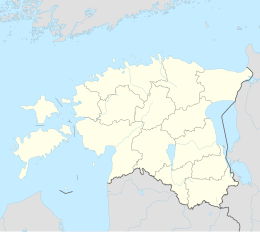Järvakandi
| Järvakandi | |||
|
|||
| State : |
|
||
| Circle : |
|
||
| Coordinates : | 58 ° 47 ' N , 24 ° 50' E | ||
| Area : | 4.83 km² | ||
| Residents : | 1,471 (01.2007) | ||
| Population density : | 305 inhabitants per km² | ||
| Time zone : | EET (UTC + 2) | ||
| Website : | |||
|
|
|||
Järvakandi ( German Jerwakand ) is a patch ( Estonian alev ) in the rural municipality of Kehtna in the Estonian district of Rapla with an area of 4.83 km². The place has 1471 inhabitants (January 1, 2007). It is located about 29 km from Rapla .
history
The village was first mentioned as Jerwencato in 1460. The stately, two-story manor house was built from 1820. It belonged to the German Baltic noble family Hoyningen-Huene . From 1894 Oskar von Hoyningen-Huene lived here with Sophie Charlotte von Wimpffen and their son from their first marriage, Roman von Ungern-Sternberg .
After the Russian Revolution in 1905 , the manor was completely destroyed. Järvakandi is known for its glass factory founded in 1879. Between 2005 and 2012 the Rabarock Festival took place in Järvakandi.
Until 2017 the place also formed an independent municipality ( Järvakandi vald ).
Web links
- Järvakandi Municipality website (in Estonian)
- Järvakandi Glass Museum (in Estonian)
- Rabarock Music Festival (in Estonian)
Individual evidence
- ↑ Palmer: The Bloody White Baron. 2009, p. 17.


